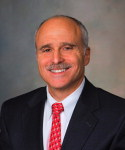Most surgeons in pain after surgery, Mayo research finds
Almost two-thirds of surgeons reported an increase in neck pain after performing surgery, and one-quarter rated their neck or lower back pain as clinically significant, a new Mayo Clinic study has found. The research was published in the Journal of American College of Surgeons.
The study also found surgeons were in a demanding neck posture 42% of the time during laparoscopic surgery, and 80% of the time during open surgery. Laparoscopic surgery involves a smaller incision and the use of a camera.
 “At the end of an operating day, a majority of surgeons hurt because of their profession,” says Samuel Money, M.D. (VASS ’06), a recently retired Mayo Clinic vascular and endovascular surgeon, and study co-author. “It may not be like the NFL, but it’s a physically demanding profession. It’s clearly concerning that we’re putting ourselves at physical risk to do our jobs.”
“At the end of an operating day, a majority of surgeons hurt because of their profession,” says Samuel Money, M.D. (VASS ’06), a recently retired Mayo Clinic vascular and endovascular surgeon, and study co-author. “It may not be like the NFL, but it’s a physically demanding profession. It’s clearly concerning that we’re putting ourselves at physical risk to do our jobs.”
The bigger picture, Dr. Money says, is that physical injuries ― just like emotional distress ― can lead to missed work and burnout for surgeons, and this affects patient access to care.
“This makes the problem of the surgeon workforce shortage even more severe,” he says. “This will increasingly come into play as our population continues to age.”
Mayo Clinic researchers followed 53 surgeons (34 men and 19 women) performing 116 procedures at Mayo Clinic in Arizona for the study. The surgeons wore devices that measured neck, upper and lower back, and arm posture during various surgeries. The surgeons also answered questionnaires before and after surgery to gauge fatigue and pain. The researchers found that pain increased after surgery in every body area studied, with the most common increases reported in the neck at 62%; lower back, 45%; and upper back, 43%. Of these surgeons, 72% also reported an increase in fatigue after surgery.
As the researchers expected, longer surgeries were correlated with more pain and fatigue. Surgeons who used loupes, or magnifying lenses, had an average increase in neck angle of 10 degrees compared to procedures without loupes.
As with neck posture, surgeons were in a demanding back posture during open surgeries 40% of the time, but just 17% of the time during laparoscopic procedures.
 “We expected to see some neck pain after longer surgeries. We didn’t expect to see the pain as high as it was, and we didn’t expect surgeons would be in these extreme angles that long,” says Susan Hallbeck, Ph.D. (HCPR ’13), a scientific director in the Mayo Clinic Robert D. and Patricia E. Kern Center for the Science of Health Care Delivery and senior author of the study.
“We expected to see some neck pain after longer surgeries. We didn’t expect to see the pain as high as it was, and we didn’t expect surgeons would be in these extreme angles that long,” says Susan Hallbeck, Ph.D. (HCPR ’13), a scientific director in the Mayo Clinic Robert D. and Patricia E. Kern Center for the Science of Health Care Delivery and senior author of the study.
Dr. Hallbeck said that although surgeon posture hasn’t changed much through the years, a number of factors have increased the burden in the operating room.
“Operating rooms continue to add equipment to address increased patient complexity. The patients are getting sicker and the surgeries are lasting longer,” she says. “So all of these things combined are a perfect storm for the surgeon to end up with musculoskeletal disorders.”
The researchers hope this study and ones like it will increase awareness of this emerging issue.
“I think it’s more common than people would have realized,” Dr. Money says. “Many surgeons have been brought up during training to assume this is part of their job. You take it because it’s part of the surgical ethos, even if it hurts you. But it doesn’t necessarily need to be that way.”
The team continues to study ways to improve surgeon physical well-being. For example, the researchers previously showed that short stretching breaks can reduce pain and improve focus without increasing the length of surgeries.
The study’s lead author is Liyun Yang, Ph.D., who was with the Mayo Clinic Kern Center for the Science of Health Care Delivery at the time of the study. Other co-authors are Melissa Morrow, Ph.D. (BME ’09, OR ’12, CTSA ’13); Bethany Lowndes, Ph.D. (HSR ’15); Tiffany Weidner, M.D. (S ’20); Emma Fortune, Ph.D. (OR ’14); Victor Davila, M.D. (VASS ’16); and Andrew Meltzer, M.D. (VASS ’18) ― all of Mayo Clinic at the time. The authors report no conflicts of interest.
The research was supported by the Mayo Clinic Robert D. and Patricia E. Kern Center for the Science of Health Care Delivery.